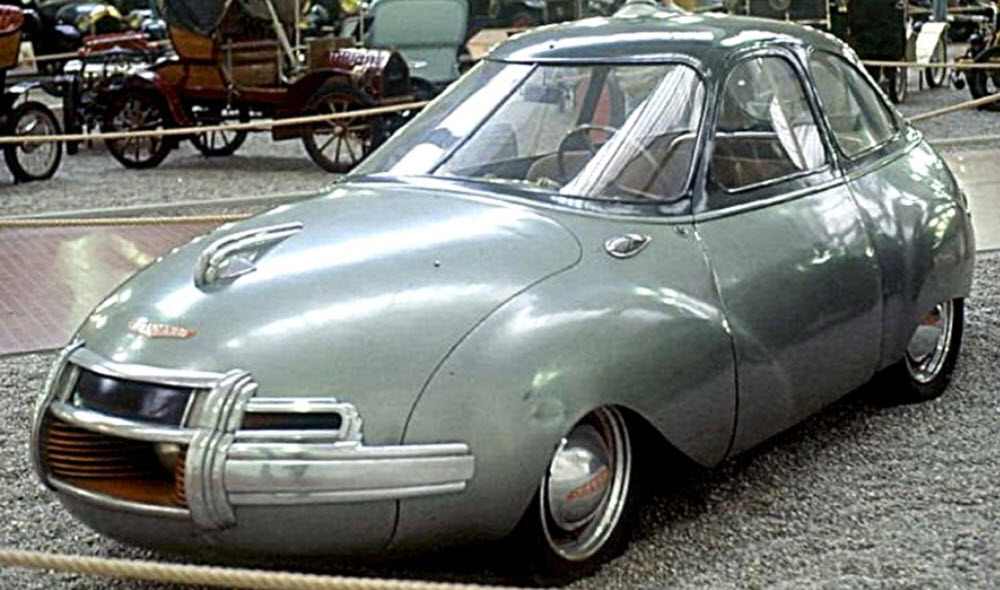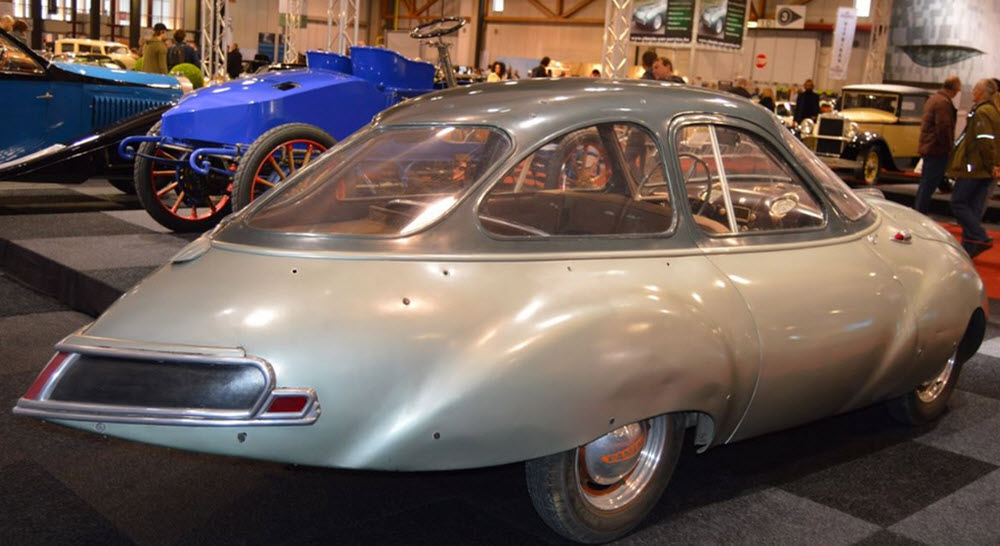Panhard Dynavia

The Dynavia was a concept automobile built by Panhard in 1948 as an aerodynamical experiment designed by Louis Bionier. Assembled in France, this 2-door front-wheel drive car sported an innovative lightweight streamlined Duralinox bodywork.
During World War II, Bionier had developed a keen interest in aerodynamics, studying the shapes and movements of birds and fishes to understand more. He even built scale models of a streamlined 7-passenger car that he called VP6. In 1945, he brought a 1/5 scale model to the wind tunnel at the Institute Aérodynamique in Saint-Cyr to test it.
Only two cars
Only two Dynavias were built:
- The very first Dynavia was unveiled at the 1948 Paris Auto Salon where it got a warm welcome from both the public and the press. It was eventually lent to museum Cité de l’Automobile in Mulhouse, France. In February 2005, it was on display at the Rétromobile show in Paris.
- A second Dynavia was built and sent to a car dealership in Grenoble, where it was purchased by Swiss person. Regretably, this Dynavia was involved in a crash and demolished.
- Parts for a third Dynavia were produced, but never assembled.
The experiences with the Dynavia helped convince Paul Panhard to let the company’s in-house designer Louis Bionier design an aerodynamic body for the Panhard Dyna Z, a lightweight motor car of which roughly 140,000 were assembled 1954-1959.

About the Dynavia
The Dynavia used the Dyna X chassis, upon which a 2-door bodywork made from Duralinox was placed. Duralinox is an extremely lightweight aluminum-magnesium alloy.
The aerodynamics of the Dynavia were so amazing that the drag coefficient stayed at 0.26. This was partly achieved through a narrow body and curving roof-line, which seriously limited the space available for passengers. The car was a four-seater, but the passenger space was not ample.
The Dynavia weighed 650 kg, which wasn’t much but still a bit more than the Dyna X. Thanks to a combination of aerodynamics and low weight, the 28 hp engine could get the car to a top speed of 131 km/h, which was circa 18% faster than what the Dyna X could do with the same drive-train.
A single floodlight sat at the center of the car’s nose, while the headlamps – Cibié “zero dazzle” units – were located in tubes in the fenders, where they projected flat beams through slots.
Engine
Panhard’s air-cooled 2-cylinder OHV GM600 boxer engine
Bore: 72 mm
Stroke: 75 mm
Total displacement: 610 cc
Capacity: 28 hp (20.9 kW) @ 4000 rpm
Location: front-mounted, driving the front wheels through a four-speed manual transaxle
Transmission
4-speed manual
Steering
Rack-and-pinion
Brakes
Drum brakes at both front and rear
Suspension
Independent suspension on all four corners
Dimensions
Wheelbase: 2120 mm
Length: 4400 mm
Width: 1700
Height: 1450
Weight
Kerb weight: 650 kg
Background
Founded in 1887 by René Panhardand Émile Levassor, the French car manufacturer Panhard et Levassor sold their first automobile in 1890.
As the World War II was drawing to an end, the leaders of Panhard et Levassor realized that things would probably not go back to early 20th century conditions where large and expensive cars dominated the European market. Instead, they foresaw an increased demand for smaller and more affordable cars.
To meet these demands, the designed Louis Bionier started working on small front-wheel driven car that would be powered by engineer Louis Delagarde’s new air-cooled 2-cylinder boxer engine.
